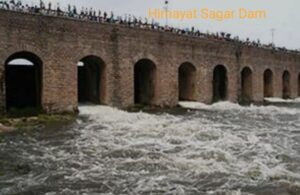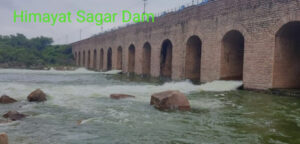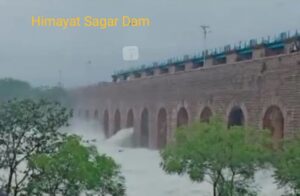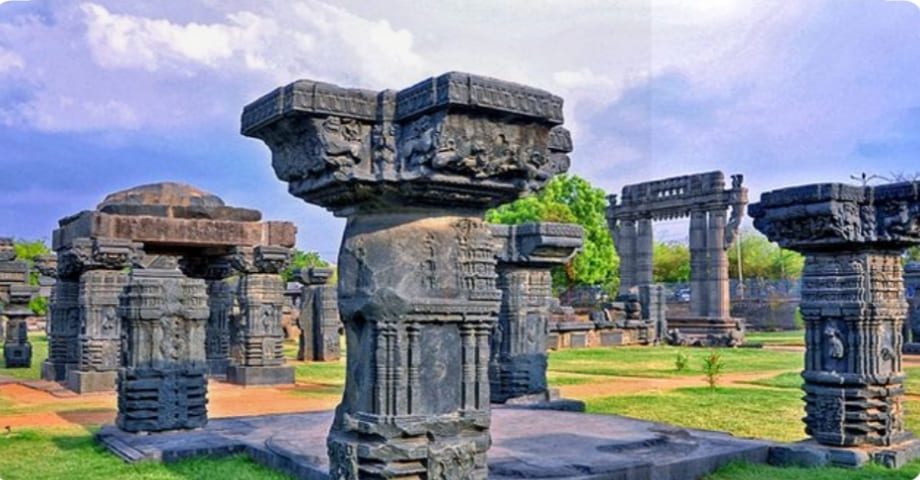The Himayat Sagar Dam, a testament to engineering prowess, stands as a vital lifeline in southern India. Constructed for water management and irrigation purposes, its significance reverberates through the lush landscapes it sustains. This colossal structure, nestled amidst the natural beauty, plays a pivotal role in regulating water resources, ensuring a steady supply for agricultural needs in the region. As a beacon of sustainable development, Himayat Sagar Dam symbolizes the seamless integration of human innovation with the environment, fostering prosperity and growth through efficient water utilization. Join us on a journey to unravel the remarkable tale of this hydraulic marvel.

1.The Genesis of Himayat Sagar Dam
•Historical background and reasons for its construction.
In the early 20th century, the need for effective water management in the Deccan region spurred the conceptualization of the Himayat Sagar Dam. The project gained momentum in the 1910s, driven by a vision to mitigate water scarcity and enhance agricultural productivity. Sir Mokshagundam Visvesvaraya, the renowned engineer, played a pivotal role in the dam’s planning and execution. The primary objectives were to harness the Krishna River’s water potential and provide a sustainable solution for irrigation in the arid lands surrounding Hyderabad. Thus, in 1927, the foundation stone was laid, marking the commencement of a transformative engineering venture.
• Overview of the decision-making process and key figures involved.
The decision to embark on the construction of Himayat Sagar Dam involved a meticulous planning process and collaboration among visionary leaders. Sir Mokshagundam Visvesvaraya, an eminent engineer and statesman, played a pivotal role in shaping the project. His expertise and strategic insights influenced the decision-making process significantly.
The project garnered support from regional leaders and administrators who recognized the potential benefits of effective water management. Government officials, engineers, and local stakeholders collaborated to navigate the complexities of resource allocation, funding, and environmental considerations.
The collective effort of these key figures culminated in the green light for constructing Himayat Sagar Dam, marking the beginning of a transformative initiative for sustainable water utilization and regional development.
•The initial purpose and vision for the dam.
Initial Purpose and Vision for Himayat Sagar Dam:
The conception of Himayat Sagar Dam was rooted in a visionary approach to address pressing agricultural and water management challenges in the Deccan region. The initial purpose was twofold:
1.Irrigation Advancement: The dam aimed to revolutionize irrigation practices by harnessing the waters of the Krishna River. The vision was to transform arid lands into fertile fields, ensuring a consistent water supply for agricultural needs. This strategic initiative sought to bolster crop yields and contribute to food security in the region.
2.Water Resource Management: Himayat Sagar Dam was envisioned as a key component of comprehensive water resource management. By regulating the flow of the Krishna River, the dam aimed to mitigate water scarcity issues, providing a reliable source for irrigation while curbing the impact of droughts on local communities.
This dual-purpose vision underscored the dam’s role as a catalyst for regional development, aligning infrastructure with the imperative needs of agriculture and sustainable water utilization.
2.Himayat Sagar Dam Engineering Marvels: Design and Construction
•Detailed insights into the engineering aspects of Himayat Sagar Dam.
Engineering Marvels of Himayat Sagar Dam:
The design and construction of Himayat Sagar Dam showcase a remarkable fusion of ingenuity and engineering prowess. Here are detailed insights into its key engineering aspects:
1.Structural Design: Himayat Sagar Dam features a gravity masonry design, where the weight of the dam itself provides stability against the pressure exerted by the impounded water. The structure spans the Musi River, creating a reservoir that serves as a crucial water storage facility.
2.Spillways and Gates: To manage water flow and prevent overflow during heavy rains, the dam is equipped with well-designed spillways. Adjustable gates offer precise control over water release, ensuring optimal regulation to meet irrigation demands and prevent flooding downstream.
3.Storage Capacity: Himayat Sagar boasts a substantial storage capacity, capable of holding millions of cubic meters of water. This capacity not only caters to immediate agricultural needs but also provides a buffer for sustained water supply during dry spells.
4.Foundation Engineering: Given the geological diversity of the region, the dam’s foundation engineering is a critical aspect. Engineers employed rigorous geotechnical studies to ensure a stable foundation, enhancing the longevity and safety of the structure.
5.Hydroelectric Potential: While primarily constructed for irrigation, the dam also taps into its hydroelectric potential. The controlled release of water through turbines generates clean energy, contributing to the region’s power requirements.
6.Monitoring and Maintenance: Advanced monitoring systems and regular maintenance protocols ensure the dam’s structural integrity. Continuous inspections and modern technology aid in identifying potential issues, allowing for timely interventions and upkeep.
Himayat Sagar Dam stands as a testament to meticulous engineering, seamlessly blending functionality, durability, and sustainability to fulfill its pivotal role in water management and agricultural development.

• Description of the dam’s design, including spillways, gates, and storage capacity.
1. Gravity Masonry Structure:
Himayat Sagar Dam employs a robust gravity masonry design, leveraging the weight of the dam itself to counteract the force of impounded water. This design ensures stability and durability, crucial for its role in water management.
2. Spillways for Controlled Water Release:
Strategically integrated spillways play a pivotal role in preventing overflow and managing water discharge during periods of excess rainfall. The spillways are meticulously engineered to maintain precise control over water flow, averting potential flooding downstream.
3. Adjustable Gates for Flow Regulation:
The dam features state-of-the-art adjustable gates that enable engineers to regulate the release of water with precision. This control mechanism ensures optimal distribution for irrigation needs, mitigating the impact of both scarcity and abundance.
4. Impressive Storage Capacity:
Himayat Sagar Dam boasts a substantial storage capacity, acting as a massive reservoir for water collection. This capacity not only addresses immediate agricultural requirements but also serves as a strategic reserve during dry spells, safeguarding against water shortages.
5. Hydroelectric Integration:
In addition to its primary role in water management, the dam incorporates hydroelectric components. Turbines within the dam harness the kinetic energy of released water, contributing to the generation of clean and sustainable energy for the region.
6. Foundation Engineering for Stability:
The dam’s foundation engineering is a critical facet of its design, considering the geological characteristics of the region. Rigorous geotechnical studies have been conducted to ensure a stable foundation, enhancing the overall resilience and safety of the structure.
7. Continuous Monitoring Systems:
Advanced monitoring systems are in place to continuously assess the dam’s structural health. This proactive approach allows for the early detection of any potential issues, facilitating timely interventions and ensuring the ongoing safety and functionality of the dam.
Himayat Sagar Dam intricate design, encompassing spillways, gates, and a substantial storage capacity, stands as a testament to engineering excellence, meeting the diverse needs of water management and irrigation in the region.
•Challenges faced during construction and innovative solutions implemented.
Challenges During Construction and Ingenious Solutions:
1.Geological Diversity:
• Challenge: The region’s geological diversity posed challenges in creating a stable foundation for the dam.
• Solution: Engineers conducted extensive geotechnical studies, implementing foundation engineering techniques to ensure the dam’s stability on varied terrains.
2.Construction Logistics:
• Challenge: Logistics presented challenges in transporting materials to the construction site, given the dam’s remote location.
• Solution: Innovative transportation methods, including the use of temporary access roads and waterways, were employed to streamline material delivery and optimize construction efficiency.
3.Labor and Workforce Management:
• Challenge: Coordinating a skilled workforce for a project of such magnitude presented logistical and management challenges.
• Solution: Training programs were initiated, equipping local workers with the necessary skills. Additionally, efficient labor management strategies were implemented to ensure a synchronized workflow.
4.Financial Constraints:
• Challenge: Budget limitations posed constraints on the project’s scale and timeline.
• Solution: Innovative financing models and collaborations with both governmental and private entities were explored. This approach ensured adequate funding for the dam’s construction while adhering to financial constraints.
5.Environmental Impact Mitigation:
• Challenge: The construction had the potential to impact the local ecosystem and wildlife.
• Solution: Comprehensive environmental impact assessments were conducted, leading to the implementation of eco-friendly construction practices and the establishment of conservation zones to protect the surrounding flora and fauna.
6.Engineering Innovation for Spillways:
• Challenge: Designing spillways to handle variable water flow required innovative solutions.
• Solution: Engineers incorporated adaptive spillway technology, allowing for precise control over water release. This innovation ensured efficient flood management and minimized the risk of downstream flooding.
7.Sedimentation Management:
• Challenge: Sedimentation buildup in the reservoir threatened the dam’s long-term effectiveness.
• Solution: Sedimentation management systems, such as sediment traps and periodic dredging operations, were implemented to maintain the reservoir’s storage capacity and ensure sustained functionality.
8.Community Engagement and Resettlement:
• Challenge: The construction necessitated the resettlement of local communities, leading to social challenges.
• Solution: A comprehensive community engagement and resettlement plan was developed, prioritizing the well-being of affected populations. This included providing alternative housing, employment opportunities, and community infrastructure.
Himayat Sagar Dam’s successful construction stands as a testament to the resilience and ingenuity of the engineering teams, overcoming multifaceted challenges through innovative solutions and meticulous planning.

3.Himayat Sagar Dam and Water Management
• Examination of the dam’s role in managing water resources.
Dam’s Crucial Role in Water Resource Management:
1. Water Storage and Regulation:
• Storage Capacity: Himayat Sagar Dam serves as a pivotal reservoir, storing vast quantities of water during periods of ample supply.
• Regulation: The dam’s adjustable gates and spillways enable precise regulation of water release, ensuring a steady flow for downstream needs while preventing floods.
2. Irrigation Enhancement:
• Agricultural Support: The primary objective of the dam is to enhance agricultural productivity. It provides a reliable water source for irrigation, transforming arid lands into fertile fields and supporting the cultivation of crops.
3. Drought Mitigation:
• Strategic Reservoir: Himayat Sagar acts as a strategic reserve during droughts, offering a lifeline to farmers and communities by releasing stored water to mitigate the impact of water scarcity.
4. Hydroelectric Power Generation:
• Clean Energy Production: Beyond irrigation, the dam contributes to sustainable development by harnessing hydroelectric power. Turbines generate clean energy, reducing dependence on non-renewable sources.
5. Downstream Water Supply:
• Urban and Industrial Needs: The regulated release of water from the dam caters to downstream urban and industrial water requirements. This ensures a reliable water supply for various sectors, fostering regional development.
6. Flood Control Measures:
• Spillways and Controlled Release: Himayat Sagar Dam plays a crucial role in flood control. Spillways and controlled water release mechanisms prevent downstream flooding during periods of heavy rainfall, safeguarding communities and infrastructure.
7. Sustainable Water Utilization:
• Balancing Act: The dam embodies a delicate balance between utilizing water resources for development and maintaining ecological sustainability. Sustainable water utilization practices are integrated to minimize environmental impact.
8. Community Water Security:
• Livelihood Support: By securing a consistent water supply, the dam contributes to community water security, ensuring that local populations have access to water for drinking, agriculture, and other essential needs.
9. Ecosystem Preservation:
• Conservation Zones: Environmental impact assessments and conservation initiatives around the dam contribute to the preservation of local ecosystems, emphasizing the importance of maintaining a harmonious balance between development and nature.
Himayat Sagar Dam, through its multifaceted water management strategies, emerges as a linchpin in ensuring sustainable water utilization, supporting agriculture, preventing floods, and fostering the overall well-being of the region it serves.
• Impact on agriculture and irrigation in the surrounding regions.
Transformative Impact on Agriculture and Irrigation:
1.Enhanced Crop Yields:
Himayat Sagar Dam has been a game-changer for agriculture in the surrounding regions, providing a consistent and reliable water supply for irrigation. This has resulted in significantly enhanced crop yields, transforming once arid lands into productive agricultural zones.
2.Year-Round Cultivation:
The dam’s water storage capabilities ensure year-round availability of water for irrigation. Farmers can cultivate multiple crops throughout the year, leading to increased agricultural diversity and economic resilience.
3.Drought Mitigation:
During periods of drought, the dam acts as a lifeline for farmers. The stored water can be strategically released to mitigate the impact of water scarcity, preventing crop failures and safeguarding the livelihoods of agricultural communities.
4.Expansion of Agricultural Land:
The controlled release of water from the dam has facilitated the expansion of agricultural land. Previously unusable or underutilized areas have been brought under cultivation, contributing to the overall growth of the agricultural sector.
5.Crop Diversification:
The availability of consistent water resources allows farmers to diversify their crops. This not only improves the nutritional variety of produce but also provides economic stability as farmers can adapt to market demands and changing agricultural trends.
6.Stabilization of Farming Communities:
Himayat Sagar Dam has played a vital role in stabilizing farming communities by providing them with a dependable water source. This stability translates to improved socio-economic conditions, reduced migration, and a stronger rural economy.
7.Increased Employment Opportunities:
The expansion of agricultural activities and the introduction of new crops create additional employment opportunities in the farming sector. This contributes to poverty alleviation and overall community development.
8.Boost to Agro-Based Industries:
The availability of water for irrigation not only benefits traditional agriculture but also supports the growth of agro-based industries. Processing units, food production, and related enterprises thrive, fostering economic development in the region.
9.Improved Quality of Produce:
Consistent irrigation from the dam ensures that crops receive adequate water, leading to improved quality and nutritional value of produce. This has a positive impact on market competitiveness and consumer satisfaction.
Himayat Sagar Dam profound impact on agriculture and irrigation underscores its pivotal role in ensuring food security, economic prosperity, and the overall well-being of the communities in the surrounding regions.
4.Himayat Sagar Dam : Environmental Impact and Biodiversity
• Analysis of the environmental effects of the dam.
Environmental Impact Analysis of Himayat Sagar Dam:
1.Positive Impacts:
• Ecosystem Preservation: The dam, by regulating water flow, contributes to preserving local ecosystems. Conservation zones around the dam provide habitats for flora and fauna, promoting biodiversity.
• Hydroelectric Power as a Clean Energy Source: The integration of hydroelectric power generation minimizes reliance on non-renewable energy sources, reducing the carbon footprint and contributing to a cleaner environment.
• Groundwater Recharge: Controlled water release supports groundwater recharge, maintaining aquifer levels and sustaining the ecological balance of the region.
• Recreation and Tourism: The reservoir created by the dam serves as a scenic attraction, fostering eco-tourism and providing recreational opportunities without significant environmental impact.
2.Negative Impacts:
• Displacement of Flora and Fauna: The creation of the reservoir may lead to the displacement of certain plant and animal species. However, conservation efforts and mitigation strategies aim to minimize this impact.
• Altered Riverine Ecosystem: The regulation of water flow can alter the natural dynamics of the riverine ecosystem downstream, affecting sediment transport and nutrient cycling. This alteration requires careful monitoring and management.
• Sedimentation Accumulation: Over time, sedimentation can accumulate in the reservoir, affecting its storage capacity and potentially impacting downstream habitats. Regular dredging operations are implemented to mitigate this issue.
• Community Displacement: The construction of the dam may have resulted in the displacement of local communities. Resettlement efforts and community development initiatives are crucial in addressing the social implications of such displacement.
3.Mitigation and Conservation Measures:
• Afforestation Programs: Planting native vegetation in and around the reservoir helps restore ecosystems, providing habitats for wildlife and stabilizing soil.
• Sediment Management: Regular dredging operations are conducted to remove accumulated sediment, maintaining the reservoir’s storage capacity and preventing downstream impacts.
•Environmental Monitoring: Continuous monitoring of water quality, biodiversity, and ecosystem health ensures timely detection of environmental changes, facilitating adaptive management strategies.
• Community Engagement: Ongoing community engagement initiatives involve local populations in environmental conservation efforts, ensuring their participation in and benefit from sustainable practices.
• Conservation Zones: Establishing dedicated conservation zones around the dam protects sensitive habitats, allowing ecosystems to thrive undisturbed.
The construction and operation of Himayat Sagar Dam have environmental implications, proactive mitigation measures and conservation initiatives are integral to minimizing negative impacts and promoting a harmonious coexistence between human development and the natural environment.

5.Himayat Sagar Dam: Tourist Attractions and Recreational Opportunities
• Highlighting the scenic beauty around Himayat Sagar Dam.
The Deccan Plateau, the environs of Himayat Sagar Dam are a captivating canvas of natural beauty. As the sun casts its golden glow upon the reservoir, a panorama of breathtaking scenes unfolds.
1.Tranquil Waterscapes:
The dam’s expansive reservoir mirrors the azure sky, creating a serene expanse that stretches as far as the eye can see. Tranquil waters invite contemplation and offer a peaceful escape from the bustle of urban life.
2.Emerald Hills and Lush Greenery:
Rolling hills draped in emerald hues surround the dam, forming a picturesque backdrop. The lush greenery, especially during the monsoons, transforms the landscape into a verdant paradise, a testament to nature’s resilience.
3.Floral Extravaganza:
Spring unveils a floral extravaganza around the dam, with vibrant blossoms painting the landscape in a myriad of colors. The diversity of flora, from native wildflowers to carefully curated gardens, adds to the visual spectacle.
4.Avian Symphony:
The dam attracts a diverse avian population. The air is filled with the melodious calls of birds as they gracefully navigate the skies or find solace in the lakeside trees. Birdwatchers revel in the opportunity to witness nature’s symphony.
5.Scenic Trails and Viewpoints:
Nature enthusiasts can explore well-maintained trails that wind through the hills, offering panoramic views of the reservoir. Strategically placed viewpoints provide captivating perspectives, making every hike an adventure of discovery.
6.Sunset Splendor:
The evening sky transforms into a canvas of warm hues during sunset. As the sun dips below the horizon, the dam’s waters shimmer with the last rays of daylight, creating a spectacle that leaves visitors in awe.
7.Boating Amidst Beauty:
Boating on the dam provides a unique vantage point to soak in the scenic surroundings. The gentle ripples of the water and the distant hills create a tranquil atmosphere, perfect for those seeking a leisurely escape.
8.Seasonal Ephemeral Wonders:
Each season brings its own magic. Autumn paints the landscape in warm tones, while winter introduces a crisp clarity to the air. Himayat Sagar Dam invites visitors to witness the ever-changing beauty of nature.
The scenic beauty around Himayat Sagar Dam is not merely a visual treat but a soul-stirring experience, inviting all who venture here to immerse themselves in the harmonious blend of nature’s wonders.
6.Himayat Sagar Dam and Sustainable Development
• Examination of how the dam contributes to sustainable development.
1.Water Resource Sustainability:
• Efficient Water Utilization: The dam facilitates sustainable water management, ensuring optimal utilization for irrigation, hydroelectric power generation, and community water supply. This balanced approach mitigates water scarcity and promotes long-term sustainability.
2.Agricultural Prosperity:
• Enhanced Crop Yield: By providing a reliable water source for irrigation, the dam plays a pivotal role in boosting agricultural productivity. This not only ensures food security but also fosters economic stability for farming communities, contributing to sustainable rural development.
3.Clean Energy Generation:
• Hydroelectric Power: Himayat Sagar Dam harnesses the power of flowing water to generate clean and renewable energy. This sustainable energy source reduces dependence on fossil fuels, mitigates environmental impact, and contributes to the region’s energy security.
4.Flood Control and Disaster Resilience:
• Mitigating Natural Disasters: The dam’s flood control measures help mitigate the impact of natural disasters. By regulating water flow during heavy rainfall, it enhances disaster resilience in downstream areas, safeguarding lives and property.
5.Economic Diversification:
• Agro-Based Industries: The sustained water supply encourages the growth of agro-based industries, fostering economic diversification. Processing units, food production, and related enterprises contribute to a more resilient and diverse regional economy.
6.Tourism and Local Economy:
• Recreational Opportunities: The scenic beauty around the dam attracts tourists, fostering tourism-related businesses. This influx of visitors stimulates the local economy, creating job opportunities and supporting small businesses.
7.Ecosystem Conservation:
• Preserving Biodiversity: Conservation zones around the dam contribute to the preservation of local ecosystems. Efforts to minimize environmental impact and protect flora and fauna promote biodiversity, aligning with sustainable ecological practices.
8.Community Well-being and Resettlement:
• Social Development: Community engagement initiatives, coupled with thoughtful resettlement strategies, prioritize the well-being of local populations. This approach ensures that the benefits of dam-related projects are inclusive and sustainable.
9.Groundwater Recharge and Environmental Balance:
• Sustaining Aquifers: The dam’s role in groundwater recharge sustains aquifers, maintaining a crucial balance in the local environment. This contributes to overall environmental health and resilience.
10.Adaptive Management and Technological Innovation:
• Continuous Improvement: The dam authorities employ adaptive management strategies and embrace technological innovations. This ensures ongoing improvements in efficiency, safety, and environmental sustainability.
Himayat Sagar Dam stands as a beacon of sustainable development, integrating water resource management, agriculture, energy generation, and community well-being. Its multifaceted contributions exemplify a holistic approach to development that prioritizes long-term environmental and socio-economic sustainability.
Conclusion:
Himayat Sagar Dam emerges as a testament to human ingenuity and environmental harmony. From its historical inception driven by visionary leaders to its transformative impact on water management, agriculture, and clean energy, the dam stands as a cornerstone of sustainable development. The lush landscapes surrounding the reservoir invite exploration, showcasing nature’s beauty. Balancing economic growth with ecological conservation, Himayat Sagar Dam not only quenches the thirst of arid lands but nurtures communities, preserves biodiversity, and paves the way for a future where progress and sustainability coexist harmoniously.
FAQs:
1.Where is Himayat Sagar located?
2.What is the use of Himayat Sagar Lake?
3.How far is Himayat Sagar from Nampally?
4.What is the capacity of Osman Sagar lake?
5.Himayat Sagar dam on which river
6.Himayat Sagar dam directions
7.Himayat Sagar Lake timings


Pingback: Manjira River in Hyderabad: A Journey Through Time and Tradition - Don't Miss Out on the best Experience - solotraveler